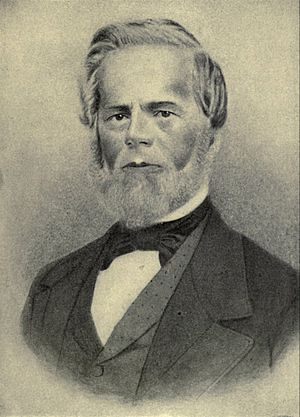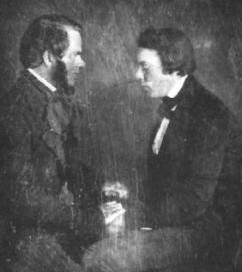Phineas Parkhurst Quimby facts for kids
Quick facts for kids
Phineas Parkhurst Quimby
|
|
|---|---|
 |
|
| Born |
Phineas Parkhurst Quimby
February 16, 1802 Lebanon, New Hampshire, United States
|
| Died | January 16, 1866 (aged 63) Belfast, Maine, United States
|
| Nationality | American |
| Occupation | Mesmerist, clockmaker, inventor |
| Known for | Founder of New Thought |
| Signature | |
 |
|
Phineas Parkhurst Quimby (born February 16, 1802 – died January 16, 1866) was an American who made clocks. He was also known for his work with the mind, especially a practice called Mesmerism. Many people see his ideas as the start of the New Thought movement, which focuses on how our thoughts can affect our lives and health.
Contents
Early Life and Health Discoveries
Phineas Quimby was born in Lebanon, New Hampshire. He was one of seven children. His father was a blacksmith. Like many kids back then, he didn't go to school for very long.
When he was young, Quimby got sick with a disease called consumption (now known as tuberculosis or TB). At that time, there was no cure for it. Doctors gave him medicine that made his teeth rot.
Quimby started trying his own ideas to feel better. He found that if he got very excited, like riding his horse super fast, his pain would go away for a little while. This made him curious about how the mind could affect the body. He later said that he cured himself of TB using these methods.
Exploring Mesmerism
Around 1836, a French man named Charles Poyen came to Maine. He gave talks about Mesmerism, which is also known as hypnotism. Quimby heard one of Poyen's talks. He thought it was a trick and didn't believe in it at first.
Later, in 1841, another person named Dr. Collyer visited Belfast. Collyer also practiced something similar to Mesmerism. His demonstrations made Quimby much more interested in the idea.
Around 1842, Quimby met a local young man named Lucius Burkmar. Lucius was very easy to hypnotize. Quimby found Lucius helpful for his work. They started touring together. Quimby would show how Mesmerism worked with Lucius in front of big crowds.
Quimby's Healing Ideas
After a while, Quimby and Lucius stopped touring. Quimby then focused on helping people with illnesses that doctors couldn't cure. Quimby believed that diseases were caused by wrong ideas or beliefs in a person's mind. He thought that by explaining this to his patients, he could help them get better.
He even wrote a flyer called "TO THE SICK" to explain his beliefs. It was an important way for him to share his ideas about healing.
Personal Life and Family
Phineas Quimby got married in 1827. He had four children. One of his sons, George, strongly believed in his father's work. George worked hard to show how his father's ideas were different from those of Mary Baker Eddy. Mary Baker Eddy was one of Quimby's patients who later started Christian Science. George kept his father's writings, but most of them were not shared with the public until the 1920s, after George had passed away.
Quimby the Inventor
Besides his work with the mind, Quimby was also a skilled watch and clockmaker. He also worked with daguerreotypes, which were early photographs. He was an inventor too and held patents for several large machines. For example, he had a patent for a "Chain saw for sawing timber, wood, metal, marble, etc." in 1834.
People Who Followed Quimby
Notable Followers
Some people who said Quimby cured them included Julius Dresser and his wife Annetta Dresser. Their son, Horatio Dresser, wrote a lot about Quimby's ideas. He collected and published many of Quimby's papers in books like Health and the Inner Life (1906) and The Quimby Manuscripts (1921).
A scholar named Barry Morton said that Quimby's constant practice of his mind-healing methods helped him discover important ways to cure illnesses that were linked to the mind (psychosomatic illnesses). Even though Quimby didn't publish his findings himself, he taught many others his methods. He helped start a special healing tradition. Some of his methods were even used by John Alexander Dowie, who changed Christian faith healing in the 1880s.
Warren Felt Evans was a minister who visited Quimby twice around 1863. While some thought he was Quimby's student, newer studies show that he saw himself as an equal to Quimby, not just a student.
See also


